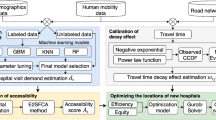Abstract
The relative performance of five simple rules for selecting facility locations are compared with two heuristic location-allocation algorithms in the context of a real region. It is hypothesized that the performance of a rule is likely to be systematically related to the spatial structure of the region in which it is used. In the Iowa settlement system, known to have predictable structural regularity, some rules performed over 95 percent of the level achieved by the algorithms (the greedy add and the modified vertex exchange algorithms) on a range of commonly used criteria for evaluating locational efficiency. Under certain circumstances, these rules may be recommended as alternatives to more formal algorithms.
Similar content being viewed by others
References
J.R. Beaumont, Location-allocation models and central place theory, in:Spatial Analysis and Location-Allocation Models, eds. A. Ghosh and G. Rushton (Van Nostrand Reinhold Co., New York, 1986) pp. 21–54.
B.J. Berry and H.G. Barnum, Aggregate relations and elemental components of central place systems, Journal of Regional Science 4 (1962) 35–68.
J.R. Borchert, American metropolitan evolution, Geographical Review 57 (1967) 301–32.
J. Brush, The hierarchy of central places in southwestern Wisconsin, Geographical Review 43 (1953) 380–402.
J. Brush and H.E. Bracey, Rural service centers in southwestern Wisconsin and southern England, Geographical Review 45 (1955) 559–69.
W. Christaller,Central Places in Southern Germany (Prentice-Hall, Englewood Cliffs, N.J., 1966).
L. Cooper, Location-allocation problems, Oper. Res. 11 (1963) 331–43.
G. Cornuejols, M.L. Fisher and G.L. Nemhauser, Location of banks accounts to optimize float: an analytic study of exact and approximate algorithms, Man. Sci. 23 (1977) 789–810.
M. Dacey, A probability model for central place locations, Annals of the Association of American Geographers 56 (1966) 550–68.
C. Daganzo,Multinomial Probit: The Theory and Its Applications to Demand Forecasting (Academic Press, New York, 1978).
B.C. Eaton and R.G. Lipsey, The theory of market preemption: the persistence of excess capacity and monopoly in growing spatial markets, Economica 46 (1979) 149–58.
P. Hansen and J.F. Thisse, Outcomes of voting and planning: Condorcet, Weber, and Rawls locations, Journal of Public Economics 16 (1981) 1–15.
J. Horowitz, Random utility models of urban nonwork travel demand: a review, Paper of the Regional Science Association 45 (1980) 125–37.
H. Hotelling, Stability in competition, Economic Journal 39 (1929) 41–57.
J.C. Hudson, A location theory for rural settlement, Annals of the Association of American Geographers 59 (1969) 365–81.
L. King, A multivariate analysis of the spacing of urban settlements in the United States, Annals of the Ass. of Am. Geographers 51 (1961) 222–33.
L. King, A quantitative expression of the pattern of urban settlements in selected areas of the United States, Tijdschrift voor Economische en Sociale Geografie 53 (1962) 1–7.
A.A. Kuehn and M.J. Hamburger, A heuristic program for locating warehouses, Management Science 9 (1963) 643–66.
R. Larson and K. Stevenson, On insensitivities in urban redistricting and facility location, Operations Research 20 (1972) 595–612.
E.E. Leamer, Locational equilibria, Jn. of Reg. Sci. 8 (1968) 229–42.
A. Losch,The Economics of Locations (Yale University Press, New Haven, Connecticut, 1954).
T.R. Mahoney, Urban history in a regional context: River towns on the upper Mississippi, 1840–1860, The Jn. of American History 72 (1985) 318–39.
F.E. Maranzana, On the location of supply points to minimize transport cost, Operations Research Quarterly 15 (1964) 261–70.
D. McFadden, Conditional logit analysis of qualitative choice behavior, in:Frontiers in Econometrics, ed. P. Zarembka (Academic Press, New York, 1974) pp. 105–42.
S.B. Park, Performance of principles for locational decision-making: Effects of the spatial structure of environments, unpublished Ph.D. dissertation, Dept. of Geog., The Uni. of Iowa, Iowa City, Ia (1988) 303pp.
J.B. Parr, Frequency distributions of central places in Southern Germany: a further analysis, Economic Geography 56 (1980) 141–54.
J.B. Parr and K.G. Denike, Theoretical problems in central place analysis, Economic Geography 46 (1970) 568–86.
C. ReVelle, R. Church and D. Schilling, A note on the location model of Holmes, Williams, and Brown, Geographical Analysis 7 (1975) 457–59.
K.E. Rosing, E.L. Hillsman and H.R. Vogelaar, The robustness of two common heuristics for thep-median problem, Env. and Plng A 11 (1979) 373–80.
G. Rushton, Analysis of spatial behavior by revealed spatial preference, Annals of the Ass. Am. Geog. 59 (1969) 391–400.
G. Rushton and J.A. Kohler, Alloc: Heuristic solution to multifacility location problems on a graph, in:Computer Programs for Location-Allocation Problems, eds. G. Rushton, M.F. Goodchild and L.M. Ostresh, Jr., Dept. of Geog., Monog. 6 (Uni. of Iowa, Iowa City, Iowa (1973) pp. 163–87.
G. Rushton, S.L. McLafferty and A. Ghosh, Equilibrium locations for public services: individual preferences and social choice, Geog. Analysis 13 (1981) 196–202.
SAS/GRAPH, Statistical analysis for social sciences: Graph, Version 5 (1985).
A.J. Scott, Dynamic location-allocation systems: some basic strategies, Env. and Plng A 3 (1971) 73–82.
R. Stock, Distance and the utilization of health facilities in rural Nigeria, Social Science and Medicine 17 (1983) 563–70.
M.B. Teitz, Toward a theory of urban public facility location,Papers of the Regional Science Association 21 (1968) 35–51.
M.B. Teitz and P. Bart, Heuristic methods for estimating the generalized vertex median of a weighted graph, Operations Research 16 (1968) 955–61.
E.N. Thomas, Toward an expanded central place model, Geographical Review 51 (1961) 400–11.
E. Thomas, The stability of distance-population size relationship for Iowa towns from 1900 to 1950, Lund Studies in Geography (Series B. Human Geography) 24 (1962) 13–30.
W. Thorngate, Efficient decision heuristics, Behavioral Science 25 (1980) 219–25.
U.S. Bureau of the Census, Census of Population and Housing, 1980: Master Area Reference File (MARF) 2, [Machine-readable data file] and [Technical documentation], Washington, D.C. (1983).
Author information
Authors and Affiliations
Rights and permissions
About this article
Cite this article
PARK, S.B. Performance of successively complex rules for locational decision-making. Ann Oper Res 18, 323–343 (1989). https://doi.org/10.1007/BF02097811
Issue Date:
DOI: https://doi.org/10.1007/BF02097811




